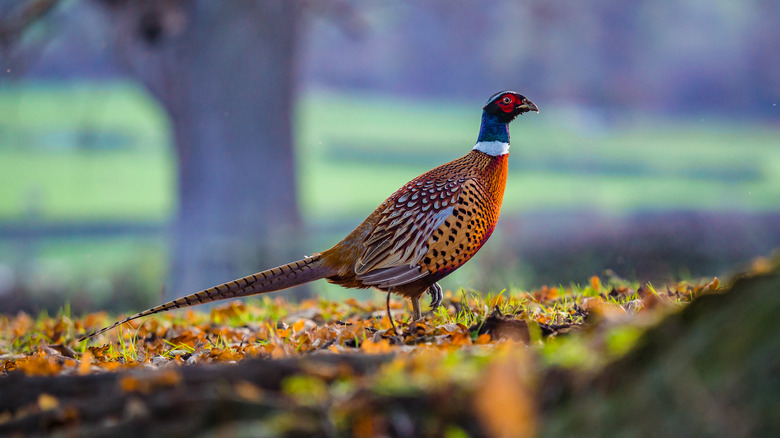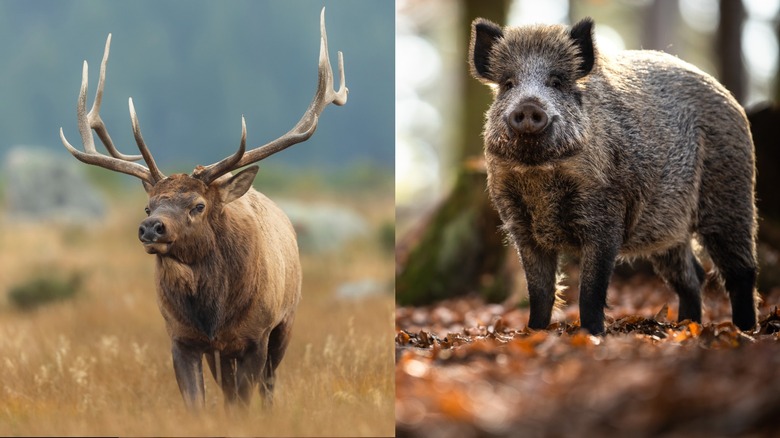The Best Game Meat To Try If You've Never Had It Before
When describing a food to someone who has never tried it before, you always want to look for comparisons. Having a familiar reference point is reassuring. However, certain foods are hard, if not impossible, to do that for, and game meat is high on that list. To clarify, game meat refers to meat from wild animals rather than farm-raised livestock. People usually describe game meat as gamey, which has to be the least helpful descriptor in the culinary world. It doesn't tell you anything unless you're already familiar with itwhat that tastes like.
Let's define what gamey means first. Game meat generally has a stronger flavor than farm-raised meat. It can also have a faint metallic taste due to the fact that wild animals live more active lives, circulating more blood throughout their muscles, thus increasing the meat's iron content. Game meat is also affected by the animal's environment, which determines their diet. It's similar to the terroir we describe with wine.
According to a Daily Meal survey, the game meat people are most curious to try is wild boar, but that might not be the best place to start if you're brand new. When dipping your toes into the world of wild game, it helps to start with something closer to the farm-raised meat you're probably familiar with. For this, pheasant is an ideal choice because it's similar to chicken while also embodying the essence of gaminess.
Pheasant is one of the most accessible game meats
Pheasants belong to the Phasianidae family, which also includes the red jungle fowl, from which domesticated chickens are descended. Pheasants are native to Central and Eastern Asia, but today, they can be found on every continent except for Antarctica. The common pheasant, also known as the ring-necked pheasant, is widespread throughout the United States, particularly the Midwest, which makes them one of the easiest game meats for Americans to try.
If you are unable or uncomfortable with hunting your own pheasant, you can get their meat from specialty butchers, online vendors, and even Whole Foods, where it's a seasonal item for the fall. In these cases, the birds are usually raised on small farms that seek to replicate natural conditions by providing large, free-roam spaces and foraging resources for the birds while avoiding antibiotics and hormones.
You can cook pheasant meat in many of the same ways you cook chicken meat. Roasting a whole bird is the best way to experience its full range of flavors. Game meat is leaner than farm-raised meat, which can make it tough and dry if cooked improperly. However, you can avoid this by brining the pheasant before roasting. Other effective cooking methods include stewing the breast meat, frying the thighs, and using the legs for a stock. The meat tastes similar to chicken but is stronger and typically sweeter.
Other game meats you should try
Another good introductory game meat is squab, which is a young pigeon. This might sound unappealing if you only know pigeons as urban pests, but squab is highly prized. It was actually the first domesticated poultry, and it is still widely farmed today in addition to being hunted. Farming squab is quite laborious, so it tends to be rather expensive. However, it has a rich, dark meat flavor and perhaps the tenderest meat of any game bird.
Moving beyond the world of game birds, we come to venison — deer meat. The flavor varies based on the animal's lifestyle, taking on some of the flavors of the herbs and acorns deers feed on. It's generally considered one of the gamier meats and can sometimes be a bit bitter. The closely related elk has a subtler, sweeter flavor, and it's become an increasingly popular restaurant offering in recent years.
Then you have wild boar. Although it's an ancestor of domesticated pigs, boar tastes more like a blend of beef and pork. The high iron content in its blood makes the meat darker, with a beef-like red hue. It should be cooked low and slow, as the meat is very lean and benefits from an overnight marinade. Wild boar are an invasive species in the U.S., and they can cause serious damage to the environment. For this reason, many states encourage hunting them, and their vast numbers make them easy to come by.


